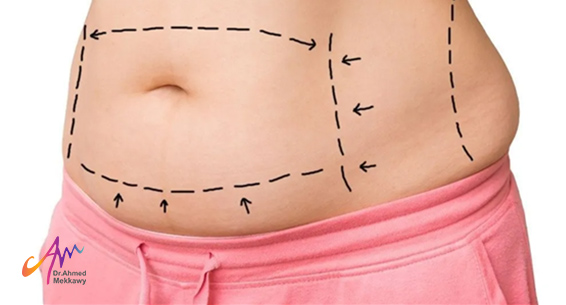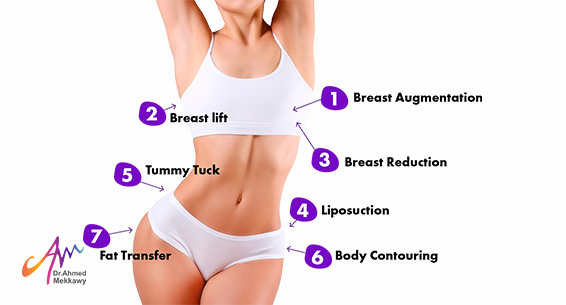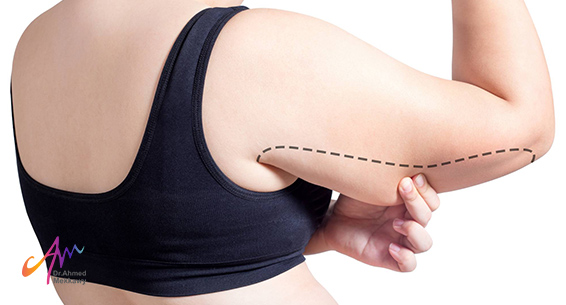Tummy Tuck

Tummy Tuck
Getting a flat and toned abdomen is a goal for many men and women. The abdomen, especially the lower part, can become prominent and saggy, which can be overcomed through plastic surgery. Abdominal sagging can be tightened in many different ways and alternatives that depend on the degree and appearance of sagging. To learn about these methods, read this article.
What is a tummy tuck?
A tummy tuck, or abdominoplasty, is a surgical procedure performed to remove excess fat and sagging skin in the abdomen. It also involves repairing torn and separated muscles and tightening weak muscles, resulting in a new shape and appearance for the abdomen with tighter and more youthful-looking skin.
Abdominal sagging can occur due to several factors that affect skin elasticity, leading to sagging and difficulty returning to its natural size. These factors include:
- Aging.
- Pregnancy and childbirth.
- Genetic factors.
- Previous surgeries, such as cesarean section.
- Fluctuations in weight.
- Significant weight loss.
- Reduced collagen.
It is not recommended for those planning to become pregnant or those who wish to lose a significant amount of weight through a tummy tuck procedure because the surgery can be affected by weight fluctuations. Additionally, pregnancy and childbirth may also affect the results of the surgery. It's important to note that the procedure cannot eliminate stretch marks; it only works to get rid of the marks present in the excess skin that is removed.
The procedure can be performed on people who are in good health, have a stable weight, are non-smokers, have positive expectations about the results of the surgery, and are not satisfied with the appearance of their sagging abdomen due to the accumulation of fatty tissue and loose skin.
Preparing for tummy tuck surgery:
Before the surgery, the doctor will discuss several important matters during the initial consultation, including:
- Goals of undergoing surgery.
- Health conditions, allergies, and medical treatments.
- Current medications, vitamins, herbal supplements, and tobacco use.
- Previous surgeries.
The doctor may:
- Discuss available options.
- Take photographs for future reference.
- Evaluate the general health condition, inquire about any pre-existing health conditions or risk factors, and test for anesthesia sensitivity.
- Recommend a set of pain medications and antibiotics.
- Discuss the expected outcomes, potential risks, risk factors, and side effects of the surgery.
It is important to ask the doctor about the recovery period, its duration, the type of anesthesia, when the stitches will be removed, the medications to be taken, or adjusted, or discontinued, the surgical facility, the risk factors, whether the person is a good candidate for the surgery, available alternatives in case of dissatisfaction with the results, and potential complications and the longevity of the results.
Preparation:
At this stage, the doctor may request laboratory tests or a medical evaluation and advise taking certain medications. He will also recommend quitting smoking and avoiding aspirin, anti-inflammatories, and herbal supplements to minimize the risk of bleeding during surgery.
Tummy tuck methods:
The tummy tuck procedure removes excess fat and skin in the upper and lower abdominal areas. It can also address sagging in the lower back area. There are several methods of tummy tuck chosen based on the degree and location of sagging:
Mini Tummy Tuck:
This procedure is performed for mild sagging resulting from a small amount of excess fat and skin below the abdomen. It allows for the removal of loose skin that is unresponsive to exercise and diet. The mini tummy tuck is performed when there is minimal excess weight and sagging in the abdominal area. However, this procedure does not repair torn or separated abdominal muscles in the abdominal wall, as surgery is performed in the lower part only, and the surgical incision is made in the lower abdomen and extends between the hips. Mini tummy tuck requires a small incision and results in less scarring.
Standard or Full Tummy Tuck:
In a full tummy tuck, the entire abdominal sagging is addressed to remove excess skin and tighten loose tissues. It also involves repairing torn or separated abdominal muscles caused by pregnancy or other factors along the entire abdominal wall. Dr. Ahmed Mekkawy makes an incision below the abdomen and around the navel. Then, he lifts the abdominal skin to reach the muscles. He then repairs and sutures them together with dissolvable sutures that break down within months. Then, the surgeon removes the excess skin from the abdomen and returns the skin to its place. The incisions are then closed. Next, the incision around the navel is addressed to remove excess skin in the upper part and place the navel in the middle of the abdomen.
Circumferential Tummy Tuck:
This procedure addresses abdominal sagging as well as the sides of the lower back. It involves tightening the upper and lower abdomen and repairing the abdominal muscles. However, the surgical incision extends around the circumference of the entire abdomen until it reaches the sides of the lower back. This surgery makes the entire abdominal and waist circumference slimmer.
Recovery after tummy tuck:
After the tummy tuck procedure, the doctor applies dressings and bandages to the incisions. He may also place small tubes to drain fluids that accumulate beneath the skin at the incision sites. He also recommends wearing a compression garment to apply pressure on the swollen areas and aid in fluid drainage. The compression garment also helps in contouring and sculpting the abdomen. Dr. Ahmed Mekkawy explains some of the following instructions:
- How to care for the drainage tubes.
- The use of antibiotics to prevent infection and reduce the risk of complications.
- Specific concerns to watch for at the incision sites and overall health.
- Follow-up appointments.
- Length of hospital stay.
- How to care for stitches and incisions.
- Duration of wearing the compression garment.
- When to resume physical activities and daily routines.
Tummy tuck results:
After the surgery, the results may not be immediately apparent due to swelling and inflammation. However, the final results become more evident as the swelling gradually subsides. Within 2 to 3 weeks, the results will begin to show, and the abdomen will appear tightened, sculpted, and more in harmony with the body.
In the case of undergoing a tummy tuck after a cesarean section, Dr. Ahmed Mekkawy can combine the cesarean scar with the tummy tuck scar. The scar fades over time until it becomes less noticeable, although it may not completely fade away. During this period, it is important to avoid putting pressure on the abdomen, lifting heavy objects, scratching the surgical incision, or subjecting it to sudden movements. It is also advised to avoid exposure to sunlight to prevent increased scarring and ensure proper recovery.
The results of a tummy tuck are long-lasting, but maintaining physical activity and a stable weight will enhance the outcomes. In the end, you will achieve a more harmonious and flat abdomen, with a slimmer and more proportionate waistline.
In conclusion, dear reader, if you are considering a tummy tuck or other methods to address abdominal sagging and would like a consultation or have more questions, you can schedule an appointment with Dr. Ahmed Mekkawy, a plastic surgery and body sculpting consultant. He is the best plastic and hair transplant surgeon in Egypt.
This content has been reviewed by Dr. Ahmed Mekkawy, a consultant in cosmetic surgery, body contouring, and natural hair transplantation.


